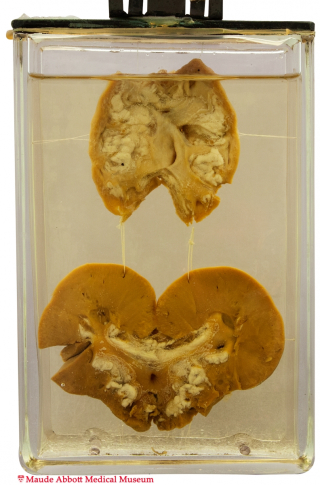

Enlarge Descriptive Card Log Book Entry
Rodin Number: 54
E Number: 10
Donor: Osler
Date: unknown
Size (H x W cm): 15 x 10
The specimen consists of two kidneys. The one on the top has a markedly thinned cortex (arrows) and increased pelvic fat (P), indicating longstanding atrophy. The one on the bottom appears structurally normal in its upper portion and atrophic below (arrows (A) and (B)).
Click on caption to enlarge image.
Comment
Although no clinical or additional pathologic information is available, the kidneys are presumably from the same patient and are meant to show both chronic disease and compensatory hypertrophy (upper part of the bottom kidney). The designation "degeneration" on the descriptive card presumably refers to the disease in the lower pole of the bottom specimen. Rodin speculates that the cause of the atrophy is chronic pyelonephritis; however, the smoothness of the cortical surface suggests a vascular rather then an infectious cause.
Osler's publication on "renal cirrhosis" (The Canada Lancet 1881, XIII: 353 - 359) is a transcript of a lecture he gave on May 28, 1881 as part of the "Summer Session Course". In it, he mentions a case of "very great atrophy of one kidney and a large red state of the other"; it is unclear if he is referring to specimen 54. An addendum at the end of the publication gives some follow-up on the patient discussed at the beginning of the lecture exemplifies Osler's characteristic style of writing.
"NOTE. -June 7th. The patient who was shown to the class on the occasion of the above lecture was recently discharged, feeling as he expressed it quite well. He was still passing about 8o ounces of urine in the day, with albumen and a few casts. He looked well, fit for life insurance, and would pass in many examinations such as I have witnessed. Yet I know of no more likely candidate for sudden death than this same patient, who has the sword of Damocles hanging over his head, ready to fall with fatal effect when the tiny hair which suspends it is suddenly broken by the onset of convulsions, or one of the other accidents to which such patients are liable.

